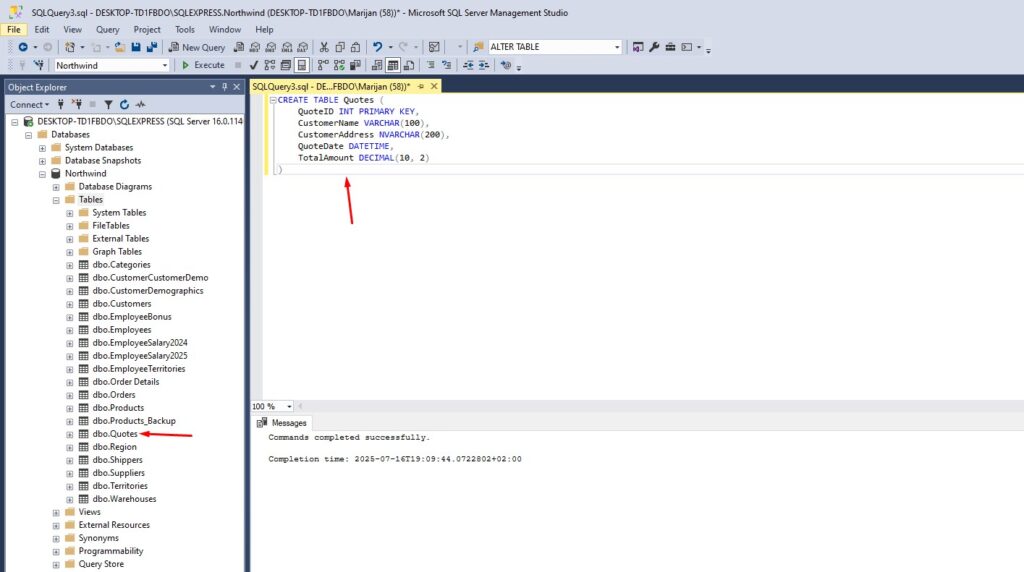When working with SQL Server, one of the first things you need to understand is data types in Microsoft SQL Server. Every column in a table needs a data type. It tells SQL Server what kind of data the column will store (e.g. text, numbers, or dates).
In this post, I’ll explain what are the data types in SQL Server, share a practical SQL Server data types list with examples, and show you how to create a table using different data types in one go.
What Are the Data Types in Microsoft SQL Server?
In SQL Server, a data type defines what kind of data you can store in a column or variable. Choosing the right data type helps SQL Server store and process your data more efficiently.
For example:
- Use text data types for names or addresses.
- Use numeric data types for prices or quantities.
- Use date/time data types for order dates or timestamps.
Now, let’s look at some examples.
SQL Server Data Types List with Examples
Here’s a simple SQL Server data types list with examples that you’ll use regularly when creating tables or working with data.
1. String (Text) Data Types
| Data Type | Description | Example |
|---|---|---|
| VARCHAR(n) | Variable-length text | ‘I Am Mika’ |
| NVARCHAR(n) | Unicode text (multi-language) | ‘北京’ |
| CHAR(n) | Fixed-length text | ‘USA’ |
| TEXT | Large text (older type) | Long descriptions |
Tip: Use NVARCHAR if you need to store special characters or multiple languages.
2. Numeric Data Types
| Data Type | Description | Example |
|---|---|---|
| INT | Whole numbers | 1000 |
| BIGINT | Large whole numbers | 1000000000 |
| DECIMAL(p,s) | Precise decimals (for money) | 26.06 |
| NUMERIC(p,s) | Same as DECIMAL | 1986.14 |
| FLOAT | Approximate decimals | 12.3456 |
Tip: Use DECIMAL or NUMERIC when you need exact numbers (e.g. for financial amounts).
3. Date and Time Data Types
| Data Type | Description | Example |
|---|---|---|
| DATE | Date only | ‘2025-06-26’ |
| TIME | Time only | ’14:30:00′ |
| DATETIME | Date and time combined | ‘2025-06-26 14:30:00’ |
| DATETIME2 | More precise date and time | ‘2025-06-26 14:30:00.1234567’ |
4. Other Useful Data Types
| Data Type | Description | Example |
|---|---|---|
| BIT | Boolean (0 or 1) | 1 (True), 0 (False) |
| UNIQUEIDENTIFIER | Globally unique ID | 550e8400-e29b-41d4-a716-446655440000 |
Example: Creating a Table Using Different Data Types
To make things more clear, here’s a real-world example of how you can create a table using different SQL Server data types together. Let’s say that, before we create orders for our customers, we need to give them quotes/offers. For this example, we will create a new table that holds information about the offers:
CREATE TABLE Quotes (
QuoteID INT PRIMARY KEY,
CustomerName VARCHAR(100),
CustomerAddress NVARCHAR(200),
QuoteDate DATETIME,
TotalAmount DECIMAL(10, 2)
)
What this does:
QuoteID: A unique number for each quote/offer.CustomerName: Stores names as regular text.CustomerAddress: Stores addresses using Unicode (good for multi-language data).QuoteDate: Records when the offer was placed.TotalAmount: Stores the total price with two decimal places, suitable for currency.
Here is what it looks like in SSMS:

Using the right data types like this makes your database easier to manage and keeps your data accurate.
Choosing the Right Data Type
Here’s a quick guide:
- Use
VARCHARorNVARCHARfor text. - Use
INTfor whole numbers unless you expect very large values. - Use
DECIMALfor prices or precise values. - Use
DATETIME2for date and time tracking.
Choosing the right data type from the start helps SQL Server handle your data better and saves space.
Also, make sure you check my previous SQL blog post on Creating Tables in SQL. And if you want to learn more about MS SQL Server data types, visit this page by Microsoft.
If you would like to learn more about programming SQL queries, make sure you buy this book: T-SQL Fundamentals (Developer Reference)
